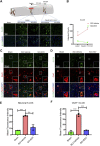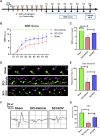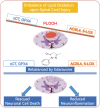Edaravone Modulates Neuronal GPX4/ACSL4/5-LOX to Promote Recovery After Spinal Cord Injury
- PMID: 35903552
- PMCID: PMC9318422
- DOI: 10.3389/fcell.2022.849854
Edaravone Modulates Neuronal GPX4/ACSL4/5-LOX to Promote Recovery After Spinal Cord Injury
Abstract
The FDA-approved drug edaravone has a neuroprotective effect on spinal cord injury (SCI) and many other central nervous system diseases. However, its molecular mechanism remains unclear. Since edaravone is a lipid peroxidation scavenger, we hypothesize that edaravone exerts its neuroprotective effect by inhibiting ferroptosis in SCI. Edaravone treatment after SCI upregulates glutathione peroxidase 4 (GPX4) and system Xc-light chain (xCT), which are anti-ferroptosis proteins. It downregulates pro-ferroptosis proteins Acyl-CoA synthetase long-chain family member 4 (ACSL4) and 5-lipoxygenase (5-LOX). The most significant changes in edaravone treatment occur in the acute phase, two days post injury. Edaravone modulates neuronal GPX4/ACSL4/5-LOX in the spinal segment below the lesion, which is critical for maintaining locomotion. Moreover, the GPX4/ACSL4/5-LOX in motor neuron is also modulated by edaravone in the spinal cord. Therefore, secondary injury below the lesion site is reversed by edaravone via ferroptosis inhibition. The cytokine array revealed that edaravone upregulated some anti-inflammatory cytokines such as IL-10, IL-13, and adiponectin. Edaravone reduced microgliosis and astrogliosis, indicating reduced neuroinflammation. Edaravone has a long-term effect on neuronal survival, spinal cord tissue sparing, and motor function recovery. In summary, we revealed a novel mechanism of edaravone in inhibiting neuronal ferroptosis in SCI. This mechanism may be generalizable to other neurological diseases.
Keywords: edaravone; ferroptosis; neuroinflammation; neuroprotection; spinal cord injury.
Copyright © 2022 Pang, Liu, Wang, Shi, Ma, Zhang, Zhou, Zhao, Zhang, Fan, Hao, Li, Zhao, Zhang, Zhou, Kong, Feng and Yao.
Conflict of interest statement
The authors declare that the research was conducted in the absence of any commercial or financial relationships that could be construed as a potential conflict of interest.
Figures








Similar articles
-
Tetramethylpyrazine alleviates ferroptosis and promotes functional recovery in spinal cord injury by regulating GPX4/ACSL4.Eur J Pharmacol. 2024 Aug 15;977:176710. doi: 10.1016/j.ejphar.2024.176710. Epub 2024 Jun 4. Eur J Pharmacol. 2024. PMID: 38843947
-
Tanshinone IIA Promotes Functional Recovery After Spinal Cord Injury by Inhibiting Neuron and Oligodendrocyte Ferroptosis Through the GPX4/ACSL4 Axis.Neurochem Res. 2025 May 16;50(3):167. doi: 10.1007/s11064-025-04414-x. Neurochem Res. 2025. PMID: 40377778
-
Inhibition of Acyl-CoA Synthetase Long-Chain Family Member 4 Facilitates Neurological Recovery After Stroke by Regulation Ferroptosis.Front Cell Neurosci. 2021 Apr 6;15:632354. doi: 10.3389/fncel.2021.632354. eCollection 2021. Front Cell Neurosci. 2021. PMID: 33889074 Free PMC article.
-
Ferroptosis: A Novel Therapeutic Direction of Spinal Cord Injury.Comput Math Methods Med. 2022 Jul 12;2022:7906218. doi: 10.1155/2022/7906218. eCollection 2022. Comput Math Methods Med. 2022. Retraction in: Comput Math Methods Med. 2023 Jul 12;2023:9863854. doi: 10.1155/2023/9863854. PMID: 35866036 Free PMC article. Retracted. Review.
-
Neuroprotective effect and possible mechanism of edaravone in rat models of spinal cord injury: a systematic review and network meta-analysis.Front Pharmacol. 2025 Apr 7;16:1538879. doi: 10.3389/fphar.2025.1538879. eCollection 2025. Front Pharmacol. 2025. PMID: 40260386 Free PMC article.
Cited by
-
The role of ACSL4 in stroke: mechanisms and potential therapeutic target.Mol Cell Biochem. 2025 Apr;480(4):2223-2246. doi: 10.1007/s11010-024-05150-6. Epub 2024 Nov 4. Mol Cell Biochem. 2025. PMID: 39496916 Free PMC article. Review.
-
Critical Roles of the Cysteine-Glutathione Axis in the Production of γ-Glutamyl Peptides in the Nervous System.Int J Mol Sci. 2023 Apr 28;24(9):8044. doi: 10.3390/ijms24098044. Int J Mol Sci. 2023. PMID: 37175751 Free PMC article. Review.
-
Ferroptosis is a new therapeutic target for spinal cord injury.Front Neurosci. 2023 Mar 14;17:1136143. doi: 10.3389/fnins.2023.1136143. eCollection 2023. Front Neurosci. 2023. PMID: 36998732 Free PMC article. Review.
-
Efficacy and safety of edaravone combined with Ginkgo Leaf Extract and Dipyridamole in the treatment of acute cerebral infarction: A systematic review and meta-analysis.Medicine (Baltimore). 2024 Nov 1;103(44):e40223. doi: 10.1097/MD.0000000000040223. Medicine (Baltimore). 2024. PMID: 39496028 Free PMC article.
-
An update on the therapeutic implications of long-chain acyl-coenzyme A synthetases in nervous system diseases.Front Neurosci. 2022 Nov 24;16:1030512. doi: 10.3389/fnins.2022.1030512. eCollection 2022. Front Neurosci. 2022. PMID: 36507355 Free PMC article. Review.
References
-
- Bracken M. B., Shepard M. J., Holford T. R., Leo-Summers L., Aldrich E. F., Fazl M., et al. (1997). Administration of Methylprednisolone for 24 or 48 hours or Tirilazad Mesylate for 48 hours in the Treatment of Acute Spinal Cord Injury. Results of the Third National Acute Spinal Cord Injury Randomized Controlled Trial. National Acute Spinal Cord Injury Study. JAMA 277 (20), 1597–1604. 10.1001/jama.1997.03540440031029 - DOI - PubMed
LinkOut - more resources
Full Text Sources

